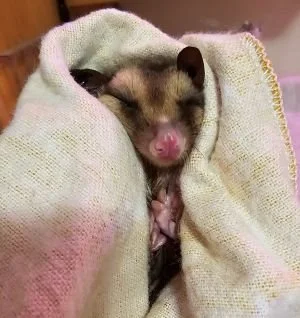🌸 S’Morie Mallow: A Gentle Spirit With a Strong Will
When S’Morie Mallow first came OOP, we thought she’d be the perfect partner for her big brother Lucky. They were still together after his neuter, and the two had already built a sibling bond. Our plan was to keep them together through weaning and eventually adopt them out as a sweet, socialized pair.
But from the beginning, something wasn’t quite right.
Her fur was always damp, and she seemed to stay curled up in the bottom of the pouch, hunched and motionless while the others clambered around above her. We thought perhaps she was being peed on or just always ended up at the bottom of the cuddle pile. But as time went on and the dampness didn’t resolve, we reached out to our mentor.
She took one look and gently said, “That looks like ick.”
🌿 What Is “Ick”?
“Ick” is a nickname in the sugar glider community for a fur and skin condition that can arise from bacterial, fungal, or yeast overgrowth. It causes the glider’s fur to look wet or greasy, and the animal often seems uncomfortable, lethargic, or hunched.
We immediately scheduled a vet appointment, and the vet took swabs of her belly—twice. But frustratingly, both results came back inconclusive. We didn’t have a clear diagnosis or a prescription treatment plan.
So, we leaned on the wisdom of other long-time glider keepers, comparing notes and researching everything we could. Based on their experience, we began a supportive routine focused on improving her condition from the outside in.
✨ Before and After
🎥 S’Morie in July – Right Before Her Bath
In this video from July 23, you can see a snapshot of what we were dealing with. S’Morie’s fur appears discolored and wet, and her posture is noticeably hunched. But you can also see that sweet little spirit inside her, trusting us even when things were scary.
🛁 A Healing Routine
We started bathing her regularly with antifungal and anti-yeast shampoos designed for small exotics. It wasn’t something we took lightly—sugar gliders should almost never be bathed—but it was one of the few options we had available.
In addition, we separated Lucky out and placed him with the Aetherwood Sisters to avoid possible spread or cross-contamination. (He was unaffected and has continued to thrive.)
S’Morie hated her first few baths, but she slowly began to relax once she realized the water wasn’t hurting her. Now, when we gently hold her in the warm water, she tenses up only for a moment before softening into the experience. Her fur has begun to regrow clean, dry, and plush. Her hunched posture has mostly resolved, and she’s more alert, social, and active every day.
🧼 A Note on Bathing Sugar Gliders
Bathing sugar gliders is not a normal part of their care. These animals are meticulous groomers and do not need human intervention to stay clean. In fact, unnecessary bathing can be very stressful and even dangerous for them.
In S’Morie’s case, bathing was a last resort—used only after:
Two inconclusive vet swabs
No access to internal treatment
Guidance from a mentor and an experienced glider keeper
If you suspect something like this in your glider, we encourage you to consult an exotic vet immediately. Self-treatment without guidance can do more harm than good.
📸 [Photo from October 2] captures a very different joey: wrapped in a towel like a baby burrito, pink nose peeking out, soft fur fluffed and eyes peacefully closed. A fighter, resting.
🌸 Stronger Every Day
Today, S’Morie is doing much better. Her fur is softening, her eyes are bright, and her personality is blossoming. We’re not sure yet whether she’ll stay with us or be adopted out, but we do know she’s on the right track—and that her journey matters.
She reminds us that sometimes the smallest gliders need the biggest care—but they return that care in spades, just by being themselves.
🖋️ —The Grove Keepers (with Fable Quillvine, Archivist of the Grove)
